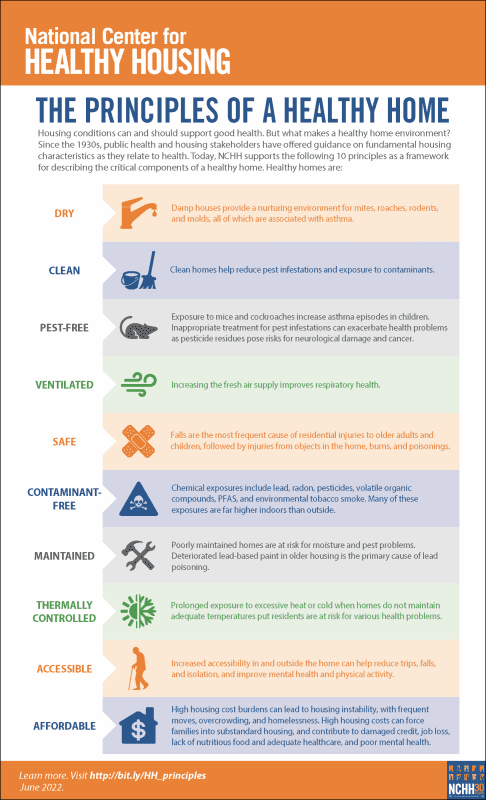The Principles of a Healthy Home
Housing conditions can and should support good health, but what makes a healthy home environment?
A healthy home is one that is dry, clean, safe, ventilated, free of pests and contaminants, well maintained, and thermally comfortable. In addition, homes should be affordable and accessible to all people, regardless of age or ability.
The 10 principles described in greater detail below provide a framework for describing the critical components of a healthy home. Healthy homes are:
 Dry: Damp houses provide a nurturing environment for mites, roaches, rodents, and molds, all of which are associated with asthma.
Dry: Damp houses provide a nurturing environment for mites, roaches, rodents, and molds, all of which are associated with asthma.
Clean: Clean homes help reduce pest infestations and exposure to contaminants.
Pest-Free: Recent studies show a causal relationship between exposure to mice and cockroaches and asthma episodes in children; yet inappropriate treatment for pest infestations can exacerbate health problems, since pesticide residues in homes pose risks for neurological damage and cancer.
Ventilated: Studies show that increasing the fresh air supply in a home improves respiratory health.
Safe: The majority of injuries among children occur in the home. Falls are the most frequent cause of residential injuries to children, followed by injuries from objects in the home, burns, and poisonings.
Contaminant-Free: Chemical exposures include lead, radon, pesticides, volatile organic compounds, PFAS, and environmental tobacco smoke. Exposures to asbestos particles, radon gas, carbon monoxide, and secondhand tobacco smoke are far higher indoors than outside.
Maintained: Poorly maintained homes are at risk for moisture and pest problems. Deteriorated lead-based paint in older housing is the primary cause of lead poisoning, which affects some 535,000 U.S. children annually.
Thermally Controlled: Tenants and homeowners are at risk for various health problems related to prolonged exposure to excessive heat or cold when their homes do not maintain adequate temperatures.
Accessible: Modifications are often necessary in order for occupants to move safely in their homes. Lack of accessibility in and outside the home can result in reduced physical activity, trips, falls, isolation from family and friends, and poor mental health. New homes should be designed for the accessibility of all possible occupants, regardless of their age or mobility.
Affordable: Households in which more than 30% of the income in spent on housing are considered to be cost burdened; if they spend more than 50% of their income on housing, they are considered severely cost burdened. High housing cost burden can lead to housing instability in the forms of difficulty paying rents or mortgages, evictions or foreclosures, frequent moves, overcrowding, living with relatives or friends, and homelessness. The high cost of housing can drive families into substandard housing, often in unsafe neighborhoods, can lead to damaged credit, job loss, lack of nutritious food and adequate healthcare, and poor mental health.
Latest page update: March 17, 2023.